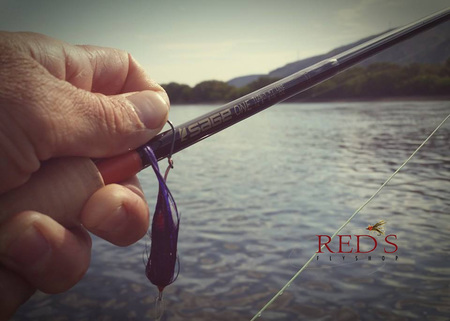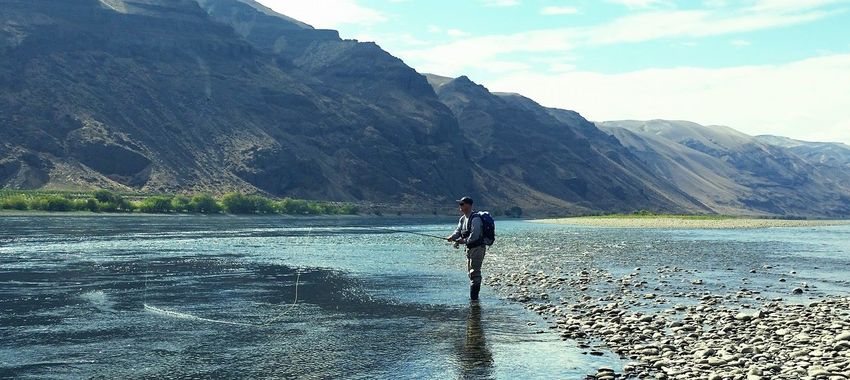Chinook Fishing, Big Water, and Thoughts on Spey Gear
September 20, 2014
Two days ago my best guide buddy and founding partner of Red's, Steve Joyce, and I took off to go do some personal R&D Chinook Fishing with spey rods on the last free flowing section of the Columbia River called the Hanford Reach. I had fished there years ago and actually caught my first Steelhead on the swing right there on the mighty Columbia. For those that have never been there before - this water moves! It has strong currents, boulders, and is a thing of beauty to cast a fly into. It is indeed BIG WATER.

We were pursuing Chinook but more importantly trying to find some new spots that fish well on a spey rod. I had fished Smallmouth out there and knew of a few bars that looked good at the time for swinging flies. As guides and shop owners it is hard to pull away from guiding this time of year, but we are constantly trying to find exciting new fisheries. It also doesn't hurt that over 20,000 Chinook a day are coming over Bonneville Dam. That's right 20,000 per day!!!!!! Not 2,000. 20,000. If I could just hook a couple of those on a spey rod on that big of water in good current it would be a good victory.
Both of us had to drop kids off at school in the morning so we got a late start leaving town. This was more of a scouting trip anyway so stumbling around in the dark wasn't going to do us any good. We finally found the spot that I dubbed "Autobahn" around 10:30 am - way past prime time for traveling Chinook. It is a big, fast, and long run. You could spend a few hours in it easy. We fished 4 hours and since we are fishing for migrating fish we really didn't feel like we had tired it out.
This run is about 1/2 mile long and has lots of current and ranges from 2 - 8' deep with a few shallow bars that extend out where the fish should pause on their way up. We had fish roll near our rod tips a couple of times! When fishing water this big it is important to know that you are targeting exclusively "traveling" fish and not fish that are holding. The holding water is a bit big for us to get at with fly rods. Downriggers and big boats are better suited for that.
I got one good bump the entire time, Steve had about the same. No hook-ups but that isn't discouraging us. We need to get some more time on the water there in order to get it figured out. We also need to get out there EARLY in the morning when those fish are traveling the edges in vulnerable water. Both Steelhead and Chinook tend to follow the edges when they migrate.
Thoughts on Spey Gear for Big Water
Here are the setups we fished:

Joe: 7126-4 Sage ONE with a 525 Grain Skagit MAX head, RIO connect core .032 running line, RIO MOW 10' T-11 sink tip
Steve: 13' 8/9 G Loomis NRX with a 525 Skagit Intermediate head, RIO 44 pound Grip Shooter running line, RIO 10' 7.0 ips versi leader
*I know the sink tips on this probably sound way heavy - I thought the same thing but I didn't snag bottom once even in the shallow sections. There is that much current on the Reach!
I had a couple of serious epiphanies while fishing on Autobahn the other day. #1, Scandi heads are awesome on big water like this. After about the first 20 casts I was wishing I had one and would have paid $100 to anyone that would have sold it to me. The longer head is so much more stable in flight and although I was throwing a heavy sink tip I could have easily gotten the same effect from a nice think little RIO Spey Versileader that would have cast so much better! (RIO MOW tips are great for big flies at reasonable distances, but RIO Spey Versileaders are thinner, lighter, and although they won't turn over big flies they shoot through the air much more efficiently). A big sparse fly would have been just fine.
The RIO Steelhead Scandi head at 480 grains (perfect for the 7126-4 ONE) is 34' long, versus 23' on the Skagit MAX head that I was using. That would have 9' less line that I would have had to strip every time not to mention Scandinavian style spey lines throw tighter loops are more stable. I am a pretty good caster but when I was pushing for distance my casting loops somersaulted and fell apart from time to time. That Skagit head is a bit squirrelly.
Steve said the same thing about his setup. When fishing technical currents, structure, and pools the Skagit iFlight (intermediate) is great but on the big wide bars we were fishing the other day it was just too short of a head. He was fresh back from a BC trip where he fished a bunch of various Steelhead Rivers and the Skagit iFlight (intermediate) was the most productive head in the group. Because it gets under the fierce surface currents it tends to swing slower and present the fly better. On the Columbia bars we were fishing the current was pretty much the same from surface to the bottom so it wasn't an advantage.
RIO Steelhead Scandi Shooting Head Wins this one.
Running/Shooting Lines:
I was never a big fan of mono running lines until about a year and a half ago. I think some of the original products like the ol' RIO SlickShooter tainted me and I had a bad taste in my mouth. I always felt like the were hard to handle, tangled, coiled, and didn't offer up much advantage. I really changed my tune two March's ago on the Methow River when my friends Mark and Charles and I spent two long days swinging for steelhead with switch rods. I really came around. The #1 thing that mono running lines do is make the tough casts easier. Off handed casts, deep wading, big flies, fatigue, etc. all make a standard cast tough to make. Mono shoots so much easier that it makes these tough casts possible.
Quick notes about Mono running lines:
- They add 25% more distance to your cast (not always a good thing, but it can be)
- Makes tough casts easier
- It "sucks up" out of the water when you shoot the line with less effort. (this equates to less fatigue)
- Does not last long, their UV properties are not great.
- The "cut through" the water giving you a nice tight feel to your fly.
- They can tangle, coil, etc. But so can all lines.
- Tough to handle with gloves on.
- Probably best if new anglers start with RIO Connect Core .032 or a 44 pound RIO Gripshooter (lighter shooting lines are less forgiving)
- You really need to try both and decide which is best for you.
Popular Mono Running Lines for Spey Fishing:
RIO GripShooter - This is our best seller, it combines the advantages of mono with a coated 14' handling section to make it easy to strip and grip. On 4- 5 weight switch/spey rods get the 25 pound model, 6-7 weight rods the 35 or 44 pound is great, on the big sticks 7 weight or heavier the 50 pound is great. This is far from an exact formula but if it is your first mono running line then error towards the heavy side.
Olympic Peninsula Skagit Tactics Lazar Shooting Line - This line seems to be preferred by the die hard spey gurus. I have not personally put it on the water but I watch the online orders come in and the fellas ordering this are also the guys that are dedicated to spey. It does not come with loops on the ends like the RIO Gripshooter so you will need to have some skills to create a perfection loop for attaching it to your shooting head. It is said to have excellent knot properties though so have no fear. Check out the video on it.
Spey Rods for Chinook and/or Big Water:
I was under gunned for this one. Steve felt better with a 13' 8/9 weight rod but a 12'6" 7 weight is a lot of work to consistently cast 80-100'. It is. I don't care how talented folks are it simply isn't the best rod for the job. On mid sized water where accuracy, short line mending, soft almost dead swings, and casting under trees is concerned.... the 7126-4 Sage ONE or METHOD are probably my favorite rods. Another one to consider is one of my long time favorites, the 12'6' Loomis GLX Stinger 7/8 (LOVE this rod!). All three are pretty similar. Quick and require a tip oriented casting stroke.
Ok, so you need some skills to fish a 12'6" rod on big water. There is no faking it out there. About 50 casts into my trip I was wishing for an 8136-4 or a 9140-4. The extra 12" -18" of length makes the cast soooooo much easier. In order to cast a 12'6" rod long distance you have to punch it pretty hard with your bottom hand. On the larger rods that casting stroke has more rod-tip-travel and this brings your fly and sink tip up closer to the surface when setting up your D loop to cast, so it is just smoother as you fire your cast. Much better!
On my next trip, I am planning on taking an 8136-4 Sage ACCEL or a 9140-4 Sage ONE with a RIO Grip Shooter 44 pound running line, RIO Steelhead Scandi Head, RIO 10' 7.0 ips Versileader, and I'll fish a large but sparse fly that has some small dumbbell eyes on it. No rabbit, maribou only and the Scandi head will be just fine on that big stick. I am hoping to head out in the morning and be back in time to cook fresh Chinook before the hawks game.
![Reds Fly Shop [logo]](/img/reds-fly-shop/logo.png)


